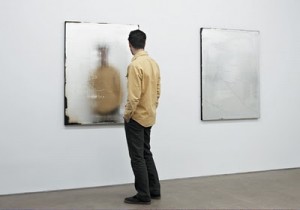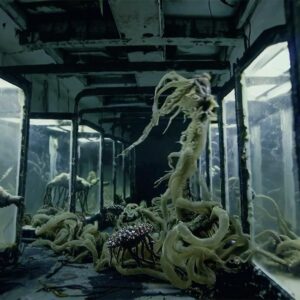
There is a new generation of artists who are realising staggeringly high prices. This group of rising stars is an all boys club of young, middle-class men. It is a perfect demonstration of the perennial confusion between price and quality, where buyers’ voracious habits steer the consensus towards judgments of artistic worth. But the market, in its inexorable whim, is not always right.
The trend for young, relatively unknown men fetching surprising prices began a few years ago with Jacob Kassay. At the age of 28, he has commanded six figure sums at auction with a series of very clever paintings which have captured the imaginations of those buyers who confuse bling with beauty. Kassay makes paintings with a unique chemical process, priming the canvas with acrylic, saturating it with chemicals, adding a layer of silver deposit and burning the edges. The result is an effect of ghostly translucence, a foggy mirror that manages only a partial reflection.
In May 2011, these paintings were selling at Philips, New York, for a respectable $30,000, but by November that year they had rocketed to $206,500. Kassay’s prices had risen according to the law of artworld chatter: buyers and money talk the right talk to the right people within a closed community. In addition to his performance in the saleroom – or perhaps, as a partial result of it – on the other side of the Atlantic, Kassay was involved in two major events in London. First, he was in the group show which opened White Cube’s monumental Bermondsey space to great fanfare; and second, he had a solo show at London’s prestigious ICA, known for its championing of emerging talent.
This shows how careers are made in the artworld: arbitrarily, by sleight of hand of the market, with less focus on the work than on the amount of hubris it can generate. So it goes in art. The market is the engine which powers the reputation machine, leading the world to think prices denote quality and deserve critical acclaim.
The same happened with Oscar Murillo, who recently had a show at the South London Gallery and is represented by the powerhouse of David Zwirner. Murillo, aged 25, makes messy paintings which affect an awkward fusion of a poor-man’s Basquiat aesthetic with Latin American sensibilities, selling at Christie’s for £192,000. Kenny Schachter quips that every Murillo ever made – and they are abundant already – has changed hands at least once. Such is the market for these young men, that the buzz leads to constant exchange, as if no one sincerely appreciates them as anything other than handy alternative currencies.
The danger here is clear to see if you remove the rose-tinted glasses of market success. These boys are enjoying the convincing simulacrum of artistic success, driven to mass-produce the works which buyers are queuing up to get hold of only to sell them on again a year later, as if an endless journey through the market equates finely honed talent. But they currently lack the solid critical foundation on which their work can be taken seriously as art rather than as commodity.
There is a sense in which these artists are making work which speaks to the zeitgeist of the market, which fulfils a need in the culture and gap in the collectors’ sense of their own trendiness. Kassay and Murillo are on the right side of the aesthetic favoured by buyers: the former, a stark, cool, glitzy loft-apartment minimalism, and the latter, a seemingly politicised, energetic, youthful street vibe. On the one hand, a pristine, clean-cut boy from New York State, on the other hand, an edgy, self-aware lad from Columbia.
I don’t mean any disrespect to these boys, but as a philosopher I am concerned to unravel the entanglement of market success with cultural worth, which it seems is operating in the case of Kassay and Murillo. The market might be a reliable taste-maker, but it is not thereby a guarantor of aesthetic quality. Kassay’s paintings are beautiful objects, but they are high fashion for a low art audience who wants to muscle in on the trendy nowness of contemporary art. They have an instant appeal, which wanes once one has seen more than a couple of them; this kind of minimalist painting goes through phases of popularity, but when it is mass-produced for a hungry market, the aesthetic shimmer begins to fade and everything starts to look the same as both itself and something we have seen before.
While Kassay is operating within, and exhausting, a tradition, Murillo is stuck like a leach to the more recent and more instantly cool idea – rather than concrete reality – of street art. The artworld likes this at the moment because it promises a renewed political consciousness that will engage art with the difficulties of the 21st Century. It also thinks that the street is a sort of conceptual Other to the gallery, where white cubes are replaced by gritty scenes of gang warfare, racial discontent and an alarming but exhilarating contingency. Murillo typifies the middle-aged, middle-class adult’s fantasy of a wayward but essentially good kid who enables them to relive their own youth. The net result in both cases is an immaculate conception of fashion, but a short-shortsightedness in terms of real cultural longevity – while both artists have their merits, there is nothing yet convincing in the work that promises any serious development or that we have any reason to remember it apart from its market performance.
It seems as if the market has sold the work on the basis of an all-encompassing popularity contest where the art is driven into public consciousness on the basis of a PR stunt. It is difficult not to notice that, whilst there are plenty of such artists just out of school, the ones pounced upon by the market happen to be well-educated, ultra-fashionable, malleable young men who have enough personality and artistic prowess to sell, but not so much as to make grand promises about the future. It’s as if Art sought advice from Pop, who said ‘sure, Justin Beiber is pretty and he makes money, but you can’t take him anywhere’.
Words: Daniel Barnes
Next week, Daniel concludes with Rising Stars: Part II, on the exceptional case of Eddie Peake.







